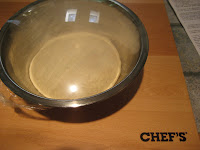Dough (makes 1 sheet pan of crackers)
1 1/2 c. bread flour
1/2 t. salt
1/2 t. instant yeast
1 T. agave syrup or sugar
1 T. vegetable oil
3-4 fl oz. water, room temperature
There are a few distinct steps to making any bread dough. To begin, you measure and mix the ingredients. The recipe I used just said to mix all ingredients together in a bowl, but I prefer to mix the dry and liquid ingredients separately and then add the liquids to the center of the dry and mix, adding more liquid as necessary. Also, I did not have instant yeast, so I found a conversion chart on the web and substituted 1/2 t. + 1/8 t. active dry yeast.
Once the dough is mixed into a ball, it needs to be kneaded for a while to develop the gluten. Gluten is the protein in wheat that develops when the dough is kneaded with some liquid. Some flours are naturally higher in protein content, like bread flour, and are more appropriate for forming an elastic dough. (As an aside, flours with less protein, like cake flour or even all-purpose flour, are usually used for cakes, cookies or pastries that you do not want to be tough or chewy. The instructions also usually indicate not to overmix the batter/dough.) It took me about 12 minutes to knead this dough to the appropriate texture. When it is ready, it should pass the "windowpane test" (google it!), be smooth, stretchy and somewhat firm. Form it into a nice ball, put it into a lightly oiled bowl, then cover with plastic wrap and set it in a warm (not hot!) place to rise.
Now it is time for the fermentation! This is the key to yeasted doughs! In a nutshell, rising / fermentation is when the LIVE yeasts are eating!! Specifically in this dough, the yeast, when combined with something sugar or agave and warmed, begins to feed. Yeast feeds best at a nice, warm temperature. Too hot and the yeasts die, too cold and they slow down or become dormant. Depending on the temperature of your kitchen, the fermentation process for this recipe will take about 90-120 minutes. You'll know it's ready when the dough has doubled in size and the plastic wrap is poofing out. A little more science here - the byproduct of yeasts feeding on sugar is carbon dioxide and alcohol. (Did you know that beer and wine are also produced by feeding yeasts?!?! Sure you did.)

Now, preheat the oven to 350 and mist your workspace lightly with oil. Transfer the dough to the workspace. With your fingers, gently form the blob into a square, lightly sprinkle some flour over the top and begin using a rolling pin to roll out the dough. You may have to stop periodically to let the dough rest or relax. Working the dough now has the same effect as when you kneaded it early. Too much working and you develop more gluten, which equals more elasticity, which means that your dough might not stay where you roll it to! Take a 5 minute break, come back and check again. You also might want to periodically lift the corners of your dough up and shake them out to stretch it more. The final size of your cracker will depend on how thin you've rolled it. I like a nice thin cracker, so I kept going until it was almost translucent. Once the cracker is rolled out, gently move it to a parchment-lined baking sheet. If you want cut or shaped crackers, you can use a rolling blade or pizza cutter to precut the dough. You do not need to separate it, as it will snap apart after baking. If you want rough shards, just leave the sheet whole.
Pop the sheet into the oven and bake for about 20 minutes, just until the cracker is browning evenly across the top. Of course, if your dough is thicker, it might take a little longer. Remove the pan from the oven, let the crackers cool for about 10 minutes, then break (or snap on precut lines) them apart and serve!
I chose to serve my Cinnamon Sugar lavash with a Creamy White Peach dip. For the dip, I blended 2 cut peaches, 6 oz. plain yogurt (you can use soy yogurt for a vegan version), 2 T. brown sugar and about 1 t. lemon juice in a food processor. Serve, dip and enjoy!



Mmm, your lavash looks wonderful! Great job on the challenge!!
ReplyDelete